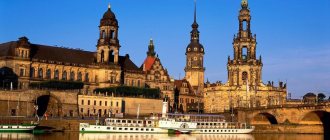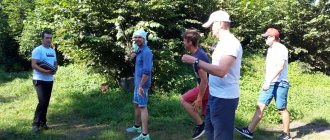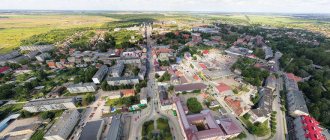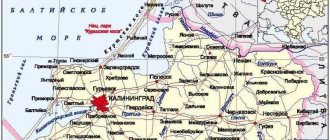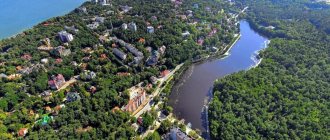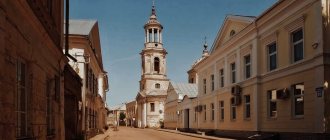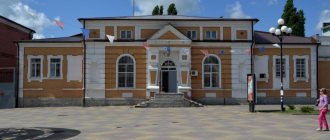Pravdinsk: TOP-5 things to see in one day
Among the huge number of interesting places, one can highlight sights that most fully reflect the history and culture of Pravdinsk.
Friedland Castle
- Address: st. Chernyakhovskogo/st. Bagration.
Friedland Castle was founded in 1312. After 35 years, it was captured and destroyed by the Lithuanians, but all the damage caused was compensated when control of the castle again passed to the Teutonic Order. The walls were rebuilt, the ditches were deepened and expanded. Two observation towers of the most powerful design were added to the complex.
The castle served defensive purposes until the 19th century. In 1820, many of its components, including the towers and part of the walls, were demolished. In subsequent decades, the castle changed its purpose. It served as a prison, a storage facility, and was eventually abandoned.
Currently, all that remains of the once impressive structure is part of the wall and the western moat. The structure of the fortress wall preserves original stonework from the 14th century. The second level is made of brick and dates from the 17th century.
The ruins of the fortress are actively visited by tourists. There are paths along the earthen rampart, the length of which is equal to the length of the wall. Walking along this path you can see the remains of stone stairs and the outlines of filled ditches.
Historical and cultural park-museum “Medieval settlement Ushkuy”
- Coordinates on the map: 54.471683, 21.066057.
On the picturesque bank of the Lava River, a few kilometers from Pravdinsk, there is a museum that transports tourists to the Middle Ages. On the territory of the Ushkui settlement, log huts, wells, bridges and outbuildings that made up the landscape of cities such as Friedland more than 700 years ago have been recreated.
The city is surrounded by a wooden fortress wall. Stone-lined paths run from the massive gates, leading tourists to exhibitions, souvenir shops and gazebos with refreshments.
The atmosphere of the medieval settlement is enlivened by guides in folk costumes, musicians playing ancient instruments and elements of peasant life: carts, baskets of vegetables, clay pots, livestock, haystacks.
Entertainment programs provide a lot of impressions to tourists: demonstration fist fights, performances of folk ensembles, as well as master classes in archery, pottery, wicker weaving and handling real swords. It’s no less exciting to join a rafting trip down the Lava River on a flat-bottomed boat called Ushkui.
The park museum is open from April to October. You can visit it only by appointment in a group of 20 people. In addition, tourists can rent the park for a wedding or children's party.
Temple of St. George
- Address: Stolyarnaya st., 13.
The history of St. George's Church began in 1313 with a wooden church. It burned down during the Lithuanian attack, after which it was rebuilt in stone. At the end of the 14th century, after a large-scale reconstruction, the church acquired its final appearance. It is a five-tiered tower in the Gothic style. Its height exceeds 60 meters.
On the top floor on four sides there is a clock that is still in use. Adjacent to the tower is a one-story building with narrow, frequent windows. The western end ends with a stepped gable. In 1772, the church was struck by lightning, after which its roof was replaced with a cone-shaped spire covered with tiles. At the same time, a jagged comb was created along the square.
The church was not damaged during the Second World War, but suffered destruction and desecration. In the post-war years, it received the status of an architectural monument, but this fact did not prevent it from being equipped with a warehouse in 1961.
Without proper maintenance, the building began to collapse. Renovations were carried out in the 1980s. During the restoration of the attic, workers discovered ancient coins and documents. Today these finds can be seen in the museum. In 1990, the church was transferred to the Russian Orthodox Church and today operates as an Orthodox church.
We have already visited most of the Kaliningrad region, but there are still cities on our list that you definitely need to visit and see the beauty of these places, as well as get acquainted with history. This time we reached the smallest city in the Kaliningrad region, which occupies only ten square kilometers in area. Until 1946, it was called Friedland, and in 1807, the well-known Battle of Friedland took place on these lands, where French and Russian troops fought in battle.
The city of Pravdinsk can leave an indelible impression on a person who appreciates history and the architecture of a past era that has been preserved through the centuries. You can get around the city in just a few hours; according to our observations, in Pravdinsk they are working on laying modern sidewalks, there are pedestrian crossings, and there is very little car traffic. On a nice sunny day, it’s a pleasure to spend time in a small cozy town.
ATTRACTIONS:
Perhaps the main attraction in Pravdinsk is the Cathedral of St. George or the Friedland Church, the structure of which is more than 700 hundred years old. The beginning of the history of this cathedral takes us to 1313, literally a year after the founding of Friedland. The church was originally made of wood, but after it was burned by the Lithuanians in 1347, it was rebuilt in stone. Already in 1510, the church acquired its modern appearance; like many buildings, it was built in the Gothic style with an attached tower 60 meters high, where an observation deck was located. During the Battle of Friedland, Russian troops used this tower as an observation post.
At the end of the 1980s, messages to descendants in the form of documents and coins were found in the spire on the tower, when restoration took place. Now all this is stored in the local history museum of Pravdinsk. An interesting fact in the history of the church is that until 1525 it was considered Catholic, and after, until 1946, evangelical.
After two wars, the church was not badly damaged, but restoration and restoration was still necessary after several decades of neglect, with the help of parishioners and former residents of the city of Friedland who live in Germany. The Church of St. George is one of the largest in the Kaliningrad region, after the Cathedral in Kaliningrad and the reform church of Insterburg - now an Orthodox church in Chernyakhovsk.
Not far from the calling card of the city of Pravdinsk there is another attraction, which was installed not so long ago, namely in 2012. The Angel of Peace monument was erected in honor of the 700th centenary of Friedland-Pravdinsk. The sculpture represents a trumpeting angel on the globe, and in the center there are tablets with countries in which there were or currently are cities with the names Friedland.
Across the road from the Angel of Peace there is another attraction and this place takes us back to the 14th century, when a new fortified city wall began to be built on the site of a burnt wooden one. This symbol of the city was built from Baltic boulders at the bottom of the wall, and hardened red brick at the top. Friedland was protected not only by walls, but also by water.
The natural “defenders” of the city were the Lava River and the Mill Pond, and the artificial one was a dug ditch along the perimeter of the city along the city wall.
Now the moat is drained, but the size is impressive
The prison building in Friedland was considered one of the most beautiful buildings in the city, built at the end of the 19th century.
There is also another attraction on Kutuzov Street, this is a bust of Field Marshal M.I. Kutuzov, which was installed in Pravdinsk in 1997. It was this monument that was located in Kaliningrad from 1953 to 1995.
Just across the road from the previous two attractions we move on to a late 17th century structure. The Great Hospital building previously had only one floor, but in 1870 a second floor was built. During the Friedland battle, Russian soldiers were stationed in this hospital; there is still a plaque on the wall about those who fought on the site of the former Friedland. It is also believed that this particular structure is described in the novel by L.N. Tolstoy "War and Peace". Now there is a kindergarten here.
On the way to another attraction preserved from the times of East Prussia, we come across a gorgeous pine forest, which was planted at the beginning of the 20th century. The forest area is 14 hectares. Now the planting of pine trees is also continuing, we noticed that the still very small trees are located in smooth alleys.
The suspension bridge has become one of the most interesting attractions in the city of Pravdinsk for us. Churches, German architecture, numerous monuments we encounter in almost every city of the Kaliningrad region, but we saw only two suspension bridges, one of which is located in Chernyakhovsk, and the second here, besides, this bridge already has a history. Built across the Lava River in the 60s of the last century, it is pedestrian. The suspension bridge was used by townspeople and workers of the hydroelectric power station.
The hydroelectric power station was built in 1924 on the Lava River, performed an important function for the Germans and was part of the East Prussian Plant joint-stock company. During the war it was significantly damaged and fell into disrepair, but was restored in 1946. From the 1970s to the 2000s it was not used due to wear and tear of the equipment. The station is now fully operational.
HOW TO GET THERE:
The distance from Kaliningrad to Pravdinsk is 52 kilometers; there are always buses operating flights to the city, or those heading to other settlements, but with stops in Pravdinsk. In addition to buses, you can get there by private vehicle or taxi. The cost of a taxi varies from 950 rubles to 1350, depending on where in the city you are moving from and which carrier you are using.
The numbers of buses that depart from the southern station of Kaliningrad to Pravdinsk are No. 173 (155 rubles), 509, 520 (cost 169 rubles), 525, 527, 554 (fare 169 rubles), 567 (inconvenient route, travel time 2 hours 18 minutes, cost 169 rubles), 620e (the most convenient, fare 140 rubles)
. You can get to Pravdinsk on any of these buses, the average travel time will be 1 hour 25 minutes, departure time is throughout the day, the interval is one and a half to two hours.
Who would we recommend to visit the city of Pravdinsk? First of all, those who are interested in the history of the region, who admire the buildings of East Prussia, and also the city will appeal to those people who love leisurely walks and uncrowded places.
You can watch a video about our trip to Pravdinsk here.
What to visit at the Pravdinsk House of Culture
The House of Culture is the main entertainment center of Pravdinsk. It combines a museum and a theater, becoming the embodiment of the history and culture of the city.
House of Culture
- Address: st. Kutuzova, 28.
The complex occupies a two-story Soviet-built building. Its facade is decorated with a mosaic panel with high reliefs of the three “Muses of Art”.
The girls symbolize music, literature and painting; they hold the corresponding attributes in their hands. The mosaic that serves as their background contains historical scenes from the formation of the city: the Battle of Friedland and the establishment of Soviet power.
On the ground floor of the building there is a concert hall where local creative groups give performances. Here you can see traditional dances, listen to ancient songs, enjoy live music of the gusli, balalaika and other folk instruments.
The House of Culture also organizes events in honor of Russian holidays: May 9, New Year, Easter, March 8 and Defender of the Fatherland Day.
Museum of Local Lore
- Address: Kutuzova street, 28.
The local history museum is located on the second floor of the House of Culture. It occupies only one room, and its exhibition is not extensive.
Here are exhibits relating to different stages of the formation of Pravdinsk: archaeological finds discovered on the territory of the castle, relics of the First and Second World Wars, elements of peasant and noble life, Soviet symbols.
Despite its modesty, the museum is loved by townspeople and tourists thanks to the enthusiasm of the guides. The museum employs people who sincerely love their homeland, know interesting details from its history and are ready to answer any question.
In the museum you can buy guides to the sights of Pravdinsk and the surrounding area. This will help tourists plan their travel route without missing out on worthwhile places.
Colorful architecture of the city of Pravdinsk
The life of modern Pravdinsk is seething within the walls of ancient Friedland. Ancient buildings serve as a tribute to the city’s past and allow you to see its historical face with your own eyes.
Former Catholic Chapel
- Address: Kutuzova, 42.
The chapel was built in 1900 in the eclectic style. This is a bright building, the ends of which end in gables with stepped friezes, and the main facade is crowned by a pediment with brick turrets. The smooth walls are decorated with interfloor belts, friezes, guttas and medallions.
The chapel ceased to operate in the 1940s and served economic purposes for a long time. It is currently occupied by a police station. Since 2016, the chapel has been included in the list of cultural heritage sites of Pravdinsk.
Water tower
- Address: Kutuzova street.
The water tower was built in 1924 on Bahnhofstrasse. This is a majestic hexagonal structure topped with a tiled tent. There are narrow windows on each face at different levels. The tower is only a hundred years old, but its appearance resembles a medieval castle.
Until 2012, the tower was used for its intended purpose - supplying clean water to nearby areas. Today it exists exclusively as a decoration of Pravdinsk and a historical monument.
Railway water tower
- Address: Kutuzova street, 45.
The water tower providing water to the railway station was erected in 1902. The structure consisted of three tiers and resembled a medieval tower.
Currently the building is in disrepair. The upper tier is lost. All that remained of the original appearance was a cylindrical silhouette, narrow window openings, and a jagged belt between the second and disappeared third tier.
The most valuable surviving element is the Prussian-style portal. The doorway is finished with keystone, massive columns and gables with decorative inlays.
Station hotel building
- Address: st. Kutuzova, 35.
The station hotel was opened at the beginning of the last century. This is a three-story, rectangular building with a hip roof. The northern facade ends in a gable with false windows, which together look like an open book.
The common detail of the four facades are double belts, as well as arched and semi-circular window niches. Since 2011, the building has been included in the list of historical and cultural heritage of Pravdinsk. Today it is occupied by an emergency department and a day hospital.
Former hospital building
- Address: Kutuzova, 16.
The hospital building is one of the oldest architectural structures in Pravdinsk. It was erected at the beginning of the 19th century. The hospital stands out against the backdrop of urban development with a gable with a clock tower, from which a huge spire rises into the heights.
In the past there was a belfry in the arch that serves as its base. The building is also decorated with sandriks, rustication and small turrets. The hospital became famous throughout Russia after L.N. Tolstoy described it in his novel War and Peace.
In the history of Friedland, the hospital was imprinted as a place where Russian soldiers who participated in the Russian-Prussian-French war of 1806-1807 were treated. The soldiers who died from their wounds were buried in a mass grave on the hospital grounds.
During the Soviet years, the hospital served its intended purpose, and today kindergarten No. 1 is opened there. In 2011, the building of this landmark was deservedly recognized as a cultural heritage site.
Folk school
- Address: st. Kutuzova, 13.
The Public School building is an architectural masterpiece. It was built at the beginning of the 20th century from baked bricks in the Art Nouveau style. The rectangular shape of the building is broken by the risalit, which ends with a gable with a stepped frieze.
Other features of the structure include flat window and door openings, a roof with Dutch-type ceramic tiles, diamond rustication in the design of the plinth, sandstones and pediments with dormer windows on the northern façade.
The public school was accessible to children from different classes. Here they received their primary education: they learned to read, write, and count. After the revolution of 1917, the People's School was transformed into a regular high school.
In 2016, this building received the status of a cultural heritage site. Currently, it houses the Shore of Hope, a shelter for children in need of social rehabilitation.
Magnificent Pravda villas and estates
The rich and nobility of Friedland lived in luxurious mansions, many of which have survived to this day.
Villa Lessing
- Address: Kutuzova, 19.
Villa Lessing has been decorating the city since the beginning of the 20th century. This is a massive structure with a hipped tiled roof and two attic floors. The narrow projection ends with a pediment with small windows.
The villa was nationalized in the 1940s and changed its use several times. Today it houses a dentistry and pharmacy. In 2011, the building received the status of a cultural heritage site in Pravdinsk.
Villa Mayer
- Address: Kutuzova, 10.
The villa was built at the beginning of the 20th century in the neo-Gothic style. The attic floor ends with a sharp gable with a dormer window. It is flanked by attic windows with wooden gable trim.
In the 1940s, the building was reconstructed: an additional door was knocked out, the veranda and balconies were demolished, and a vestibule was added. In 2011, the building received the status of a cultural heritage site. Today it is occupied by a branch of the Russian Post.
Villa Fonzee
- Address: Kutuzova, 8.
The villa was built at the turn of the 19th and 20th centuries. It is a one-story building with an attic floor. At the end of the 1940s, the villa was seized from the Fonzee family and given over to a soldiers' canteen. Today, the Amelia cafe and hotel are open there. Thanks to proper care, the building has preserved its historical appearance.
To this day it is decorated with platbands in the style of classicism, a carved patterned canopy in the attic, snow-white pilasters, an interfloor cornice, forged brackets and a balustrade. Guests of Amelia have a wonderful opportunity to spend time in the virtually untouched Friedland mansion.
Richter's estate
- Address: Kaliningradskaya street.
The estate was built in 1911 and since then has become one of the main architectural pearls of Friedland/Pravdinsk. The building is designed in eclectic style. Whitewashed decorative elements stand out on the red brick facades: rusticated stone, window frames, cornices and turrets. The risalit ends with a tong with a round dormer window. The composition is complemented by a veranda and balconies with balustrades.
Initially, the mansion belonged to the veterinarian Richter, and after the Great Patriotic War it became the property of a state farm. In the 1990s, the building was acquired by. Currently the estate is empty. Several years ago, the landmark was redecorated, but the building needs serious restoration, without which it will collapse in the near future.
Pravdinsk: what the knights of the Teutonic Order called it and who lived here on bird rights
Today in the series “Small Towns of Russia” we will go to Pravdinsk, Kaliningrad region. More than 700 years ago it was founded by knights. The city was called differently then. But the defensive ditches and fortress walls remain there to this day.
The history of this city is full of irony. Translated from German, its first name means “peaceful land,” but in its 700 years of existence there is hardly a century without bloodshed. The knights of the Teutonic Order, who built the city in 1312, gave it the name Friedland. Less than fifty years had passed before the Lithuanians set fire to the city, and the Teutons began to prepare for war.
Karina Tishkova, director of the Pravdinsky Museum of Local Lore:
“After the Lithuanians attacked Friedland and burned the wooden city, the authorities of the Teutonic Order thought that the city needed powerful protection. And they hired 500 workers, who built this wall from Baltic boulders by fitting in six months.”
The renewed Friedland was covered with a wall on all sides, and for greater security, a defensive water ditch was dug along the wall. The barrier has protected the city more than once. It was also used in a century when knights became only heroes of TV series and reconstructions.
Lesha, Daniil and Mitya, schoolchildren:
“When it’s winter, there’s a bread slide here and we go sledding on it. Sometimes they still flood here. The kids are actually sliding down the little slide over there.”
Local children have only recently started having time for fun. Before World War II, German teenagers helped their parents farm. Later, when the city became part of the Soviet Union, Soviet schoolchildren began to plow the land.
Mikhail Yakovlevich Zaitsev was among the first settlers. In 1948 he came here with his parents from Kostroma.
Mikhail Zaitsev, resident of Pravdinsk:
“They raked hay on horse-drawn rakes from morning to evening. There were 7 people in the link, 2 boys on rakes provided support. It was difficult, of course, they made 7 tons - a ton per person.”
80-year-old Mikhail Zaitsev is one of the few remaining witnesses to the transformation of German Friedland into Soviet Pravdinsk. The most painful memory, even after more than 60 years, remains the fate of the indigenous residents, who remained in the city as a bird for a whole year. They were paid almost no wages, their houses were occupied by settlers, and the Germans had no rights in the post-war Soviet Union. Only in 1949 were they deported to Germany.
Mikhail Zaitsev, resident of Pravdinsk:
“The Germans were already elderly, worked, and earned very little. They had few things, they came to the Russians, brought something, so that the Russians would give them. Life was difficult for them."
Despite the difficult parting, the Germans did not forget their hometown. In the 1990s, they began coming to Pravdinsk on nostalgic excursions, and then helped restore the city’s main attraction, St. George’s Cathedral.
The wooden temple is the same age as Friedland. For the first two hundred years, Catholics came here; in the 16th century, the church became evangelical, and under Soviet rule, the Raipo warehouse was built here. In the 90s, the dilapidated building was transferred to the Russian Orthodox Church. It was former German parishioners who raised money for the renovation.
Priest Dmitry, rector of St. George's Church in Pravdinsk:
“A native of this city, Mrs. Ursula Kluge, having left for Germany, did not forget about her native temple, and there, in Germany, she organized a club to help this temple. And they systematically transferred money here for the restoration of the temple, and helped with materials.”
Now Pravdinsk is a modest town fifty kilometers from Kaliningrad. During the war, it was almost not damaged, so new local residents mainly occupy the old German houses. Children spend their holidays in the park on the site of a former German cemetery, and adults in their free time go out with fishing rods to the quiet German river Alle, which has received a new name - Lava.
Vladimir Demchenko, fisherman:
“Well, a river... The swamp is a river, can’t you see? Skilled fishermen can catch everything. But it was better, they say.”
There are several factories in the town of four thousand people. They produce dairy products, sausages and fur coats. Nevertheless, every morning hundreds of Pravdin residents still leave to work in the regional center.
Lyudmila Titova, pensioner:
“Mainly in Kaliningrad. They travel to Kaliningrad. I have two sons, both in Kaliningrad.”
By giving Pravdinsk its name, the Soviet authorities hardly expected to be original, but they succeeded. Apart from the Kaliningrad region, there is an area with this name only near Nizhny Novgorod.
There were thirteen Friedlands in the world.
True, today only five of them have retained the name “peaceful land”. All the others, obeying historical irony, changed their name. The main attraction of the city - St. George's Cathedral - was built over a century and a half. In 1986, local authorities decided to carry out renovations there. When examining the ball that adorns the spire of the building, experts discovered historical documents and valuable coins. The find is kept today in the city museum.
War memorials and monuments of Pravdinsk
The founders of the city called it the “Land of Peace,” but it had to endure many wars, losses and tears. Today, countless monuments commemorate Friedland's exploits.
Mass grave of Soviet soldiers
- Coordinates: 54.432857, 21.010748.
The mass grave was formed during the fighting. From 1941 to 1945 More than 300 soldiers were buried here. In 1952, a research campaign was carried out, as a result of which it was possible to establish the identities of the fallen heroes.
In the same year, an obelisk with an engraved epitaph was erected at the burial site. On both sides of it are tombstones made of black granite. On them you can read the names of the fallen soldiers of Friedland.
In the early 2000s, restoration was carried out on the burial grounds: the monuments were repaired and surrounded by a fence with five-pointed stars. Between the tombstone and the obelisk there is a small stele, darkened with time. This is the first monument installed on the grave in 1945.
Eternal flame
- Address: .
The eternal flame was lit in 1949 at the foot of four steles, which taper to form a triangle. This monument marks the site of a mass grave of 200 soldiers who fell in the battles of the Second World War. There is a platform around the memorial, along the perimeter of which there are stone tombstones with the names of the soldiers.
Monument to those killed during the First and Second World Wars
- Address: Kutuzova street.
In 1914, six German and three Russian soldiers found their eternal rest in the old evangelical cemetery. In the 1950s, the cemetery was looted and the burial site was lost forever.
Nevertheless, in 1994, members of the People's Union of Germany erected a stone pedestal on the territory of the former cemetery, dedicated to all the soldiers who died in the World Wars.
On four sides of the cabinet there are memorial plaques with dedication inscriptions. It is interesting that in 1913 the pedestal served as a pedestal for another, now lost, monument. At its top stood a bronze figure of a Russian soldier with a banner in his hands.
Walk of Fame
- Address: Komsomolskaya street.
In 1995, a picturesque birch alley appeared in Pravdinsk. Walking along it, you don’t immediately realize that this peaceful place is a monument to the Second World War. On a small area surrounded by a lawn there is a memorial stone with a reinforced plaque.
Here you can read a historical note stating that the alley was planted by WWII veterans of the Pravdinsky district. This happened in honor of the 50th anniversary of the Great Victory.
Mass grave of soldiers who died in the hospital
- Address: Kutuzova, 16.
The oldest mass grave is located on the territory of the former hospital. Soldiers who died of wounds in June 1807 are buried at the foot of the building. The grave of participants in the Russian-Prussian-French war is marked by a stone stele with a dedication inscription in German.
Directly above it, on the facade of the building, there is a slab with the same inscription, but in Russian. At the base of the memorial there are models of cannonballs. The area in front of the memorial is landscaped and always maintained in decent condition.
Memorial sign "Angel of Peace"
- Address: Torgovaya Street.
The memorial sign was unveiled in honor of the 700th anniversary of the founding of “Peaceful Land”. Artist F.A. Frost created a sculpture of an angel who stands on the globe and blows a horn, calling humanity to peace. On the bugle flag you can see the dates: “1312 - 2012”.
The best on the site: Sights of the Kaliningrad region and What to see in Kaliningrad
Historical places of Pravdinsk
Going for new stories
Many major tourist sites are well known not only in their own country, but also abroad. Millions of people come to them every year. However, the city also has many places that are less popular, although no less interesting. Recently, excursions to such objects have begun to be in demand.
Travel agencies on our website are ready to offer you a non-standard rendezvous to well-known attractions. There are many advantages of ordering such a tour:
- Not all buildings are easy to find information about, especially if you don’t know about their existence;
- experienced guides will be able to take you to the most interesting and little-known places quickly and with maximum benefit - you won’t take extra steps and won’t get tired so quickly;
- If you need to cover a long distance to the next object, you will travel on a comfortable bus from a travel agency.
A professional guide will lay out the route with ingenious precision, help you get your bearings and tell you such juicy details about the object that even grandmothers on the benches will be forced to admit defeat.
Interesting historical places of Pravdinsk keep many secrets. You can have a good time listening to such stories, most of which are quite exciting. Particularly interesting are the mystical stories about the construction of the house and its famous inhabitants.
If you prefer to spend interesting leisure time with friends, looking for places associated with specific events, real or fictitious, you should contact travel agencies on our website. Professionals will organize for you a trip to places from books, in which the action takes place on the streets, in houses, shops, cafes and parks that actually exist. You can also take a tour to places associated with historical figures or events.
Active leisure in the city
Various thematic events, especially those based on the same books, are a good way to learn about your city and its history. Participants are given a specific task that needs to be completed, and for this they need to know some of the cultural places of Pravdinsk. Anyone can participate in such an event by contacting the guides on our website. You will be offered sporting events where you will need to find an object and bring it to the finish line faster than others or collect puzzle pieces hidden in historical places.
Professionals also conduct quests with riddles, in which you must first understand what historical or cultural object we are talking about in order to find the desired item. This is a great way to actively spend time with your family, friends, and colleagues. Travel agencies offer many options for conducting such games to make it fun and interesting for everyone. In addition, their rates are very flexible.
Every city has places that are a must-see for any tourist. But, besides them, there are historical places in Pravdinsk that are worth visiting in order to study the heritage of past eras, deepen your knowledge of history and your city. They're not well known, so being around them means you won't have to wait in line for a photo or worry about someone ruining your shot. Among these objects there are really interesting and unique ones, and the site’s guides are ready to show them to you. Walking and listening to stories about all the buildings around you is a great opportunity to have a good time in warm company.
The picturesque nature of Pravdinsk and its surroundings
The nature of Pravdinsk remains unchanged over the centuries. Green parks, coniferous forests and bouncy rivers - all this has long adorned the city.
City Park
- Address: Shkolnaya street.
The city park is located in the heart of Pravdinsk. A deciduous grove borders the pond and touches the historical squares of the city. From here you can see St. George's Church and other attractions. The city park is home to birch, aspen, maple and oak trees. Among them there are trees whose age is more than a century.
The park is beautiful at all times of the year. The townspeople love to take walks here, ride bicycles and relax on the benches installed along the embankment.
The main attraction of this place is the flint fountain. It consists of three bowls decorated with a convex ornament. A foamy stream splashes out from a small vessel in the upper bowl, and thin crystal streams rise from the lower bowl, overwhelming the middle bowl, and water cascades over it.
Pinery
- Address: Green street.
The lava river borders an ancient pine forest. This is a piece of wild nature in the middle of a busy city. A track and ecological trails are laid through the forest.
Many pines have been growing for centuries. There are a lot of nuts here and you can often see a squirrel. A pine forest opens onto a field overgrown with tall grasses. Tourists note that this landscape seems to have come out of a 19th-century painting or from the pages of a Pushkin poem.
Suspension bridge over the Lava River
- Address: Chernyakhovsky Lane.
There are two bridges across the Lava River: a simple pedestrian bridge and a suspension bridge, which is more popular among tourists. It is built at the end of a small natural area in the middle of Embankment Street.
Between the banks, covered with lush grasses, stretches a wooden deck suspended on cables. When walking, the bridge sways violently from side to side. The Lava River here is shallow and overgrown with water lilies. The bridge goes into the thick of a deciduous forest, where the ecological trail begins. This is the best place to relax in nature.
Pravdinsky Forest
- GPS coordinates: 54.420427, 21.032287.
Outside the city there is the Pravdinskoye reservoir, created on the Lava River. The Pravdinsky forest rustles around him. This is a corner of nature, famous for its landscapes. From the hilly areas of the forest there is a magnificent panorama of the reservoir. There are many ecological trails and picnic areas in the forest.
See also the sights of other cities of the Kaliningrad region - Neman, Gvardeysk, Svetlogorsk, Chernyakhovsk, Gusev, Sovetsk, Yantarny, Zelenogradsk and Baltiysk
Pravdinsk wins the love of tourists with its ancient beauty and medieval spirit. Indeed, this is an excellent destination for those who like long excursions through the mysterious corners of the ancient cities of the Kaliningrad region and Russia in general.

